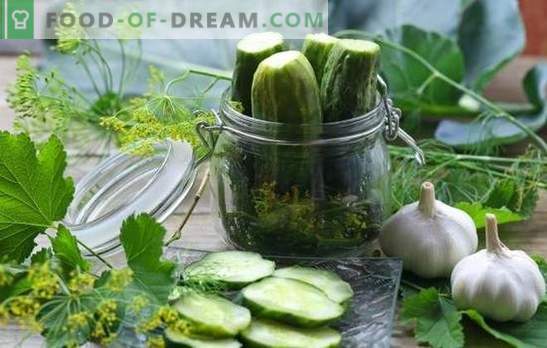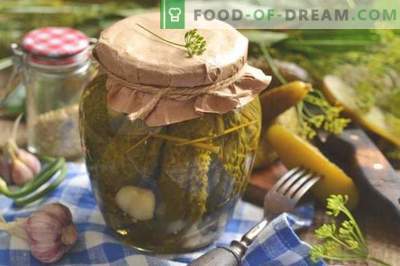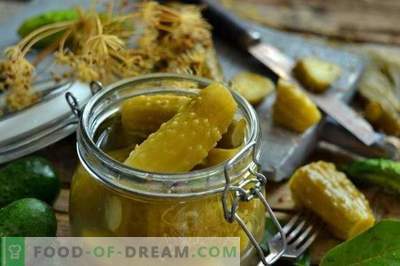
Sterilization of cucumbers for the winter in banks and the exchange of best practices in this matter is the custom of our housewives. They are always in a state of search for a new, untested recipe or a method of sterilizing cucumbers for the winter in banks.
Sterilization of cucumbers for the winter (in banks) - general principles of conservation
Every year during the ripening season of cucumbers, “canning” vanity begins. And, although, all the recipes have long been written and rewritten more than a dozen times, I want everything to be checked from the very beginning so as not to miss anything. New technologies of canning are not so much invented, so the search continues: how to make the preservation process less troublesome and time consuming.
Preservation Method 1: Sterilization
Some experts argue that at home sterilization of cucumbers for the winter in banks is possible only if there is an autoclave, with which you can achieve the required temperature of 120 ° C.
First, to create a given temperature is not such a problem. For this, just a liter of water must be added one kilogram of salt - a proven and safe method.
And, secondly, to sterilize cucumbers for the winter in banks, this temperature is not necessary. In the nineteenth century, when canning cucumbers were invented, hardly anyone used an autoclave.
At home, you can sterilize the jars in the oven, more suitable microwave. But for this, the jars need to be filled 2 cm below the edge level so that during boiling the contents do not flow out; Banks need to be covered with lids so that the liquid does not evaporate. Marinade or pickle should cover cucumbers. The temperature for sterilizing cucumbers in cans (120 ° C) can be adjusted using the on / off button of the oven.
Time sterilization cans:
0,500 ml - 2-3 minutes;
1,000 -1,500 ml - 5-7 minutes.
Immediately after sterilization, cucumbers in jars should be immediately capped, removed from the oven and turned over.
Is it possible to do without cucumber sterilization and without an autoclave? The answer is: completely. Even the salt will leave in reserve, for the preparation of canned meat. The method of sterilization at a temperature of 120 ° C is described for informational purposes only: this temperature may be needed for other household preparations. To sterilize cucumbers in cans, the methods given below are sufficient.
Preservation Method 2: Pasteurization
The most common method of home preservation is pasteurization. This method in everyday life is often called sterilization, which, from a technological point of view, is wrong.
Filled cans are immersed in large dishes with boiling water (100 ° C) and pasteurized for a time determined by the formulation and volume of cans. Packed cucumbers must be filled with freshly cooked, hot marinade, literally: remove boiling marinade from the stove and immediately pour it into jars filled with cucumbers, then immediately place the jars into the pasteurization tank into boiling water.
When pasteurizing, vinegar is best added to the marinade just before pouring into jars. Vinegar can be added to the jars after pasteurization, separately from the prepared marinade, but it is necessary to strictly observe the proportion for each jar and use measuring dishes.
The duration of pasteurization is proportional to the volume of the can:
Banks with a capacity of 0.500 ml pasteurized - 5 minutes;
1,000 ml - 1,500 ml - not less than 10 minutes;
2,000 ml - 15 minutes;
3,000 ml - up to 20 minutes.
Banks pasteurized and sealed immediately. Turning the jars, check the quality of the closures and leave them inverted until they cool down completely at room temperature.
Method of preservation 3: pickling, as an alternative to sterilization and pasteurization
This is an old canning method, without sterilization. The essence of this preservation lies in the fact that without the participation of acetic and citric acid, in a humid environment (brine), the vegetables undergo a fermentation process, in a lactic acid medium. Lactic acid, like acetic or citric, plays the role of a preservative, and formed naturally. Without sterilization, cucumbers are stored in brine, in large containers: from food-grade plastic, in enamel or ceramic dishes, in oak barrels. However, such a method of storage in an apartment of a multi-storey building is impossible: in addition to the listed conditions, a basement room is necessary.
In barrels it is difficult to keep pickled cucumbers, and in cans, as it turned out, it is possible. Resourceful housewives salted cucumbers from barrels, buckets and coxae shift into jars, poured the same boiled brine, in which cucumbers salted, pasteurized and quietly store salted cucumbers all winter, at room temperature.
In a city apartment, an acceptable option is a short-term method of salting. These are salted cucumbers that do not need long-term storage.
Preservation method 4: double fill
The whole charm of this method is to reduce the time of the whole preservation process and eliminate the need to boil water on the stove or heat the oven in the July heat, turning the kitchen into a steam room or sauna.
The double fill method is as follows:
• Put spices, cucumbers in jars, pour marinade (90-95 o), but initially - without vinegar;
• Cans of cucumbers are left to cool at room temperature;
• Next, using a plastic lid, with holes, the marinade from each jar is poured back into the pan, and again brought to a boil;
• Vinegar (citric acid or aspirin) is added to the boiled marinade, then quickly poured over the cans and immediately sealed with lids.
Sterilization of cucumbers for the winter in banks. Brine and marinade - two types and variety of flavors
For storage, in addition to the process of sterilizing cucumbers in cans for the winter, a necessary condition is the addition of acetic or citric acid: it creates an environment in the bank that stops the growth of microorganisms.
According to the content of acetic acid, marinades are divided into three types:
• Sour (from 6.5% to 9%);
• Moderate (0.41% - 0.6%)
• Slightly acidic (0.4%).
To determine the concentration of acid in the sterilization of cucumbers in the banks for the winter, at home, you can only organoleptic way: this figure is, to a greater extent, taste. An increase in the volume of acetic acid, in excess of the required minimum rate, does not affect the increase in the shelf life or the decrease in the sterilization time of cucumbers in jars for the winter.
Unlike brine, where lactic acid is present, the presence of citric or acetic acid in the marinade does not guarantee the safety of the product without hermetic sealing. Acetic and citric acid under the influence of air, undergo an oxidation process, which destroys their useful properties and adversely affects the quality of vegetable preparations. Main marinade
Years of experience sterilizing cucumbers in the banks for the winter, shows that the banks "explode" only when there is not enough vinegar in the marinade. It follows that the salt and sugar in the marinade are not the main preservatives, and their amount does not affect the quality of the preservation. The minimum amount of vinegar in the marinade is 0.050 ml / 1,000 ml of water. All other recipes for preparing the main marinade, indicating, for example, that vinegar, for the same volume of water, you need 0.200 ml - improvisation of acid lovers.
As for salt and sugar: these components, of course, are preservatives, but when adding them to the marinade, it is quite possible to be guided only by taste preferences. For the normal taste of the marinade enough:
Table vinegar (9%) - 0.050 ml;
Salt (dining room) - 0.060 g
Sahara - 0, 025 g;
Water (purified) - 1,000 ml.
To prepare the marinade, boil the water, adding salt and sugar, as soon as the liquid boils, add vinegar. Add vinegar to a boil can not, because it just evaporate.
When sterilizing cucumbers in cans for the winter, they need to be poured with a very hot marinade: the higher the temperature of the marinade during pouring, the better.
Basic brine
For pickling cucumbers, an important ingredient is sugar, since it is the one that causes the fermentation process and the formation of lactic acid. Vinegar in brine is not used, salt is added, as in the marinade - 0.060 g / 1,000 ml of water.
It is no secret that lightly salted cucumbers have a slightly sweet taste, because the fermentation process in them is not completed. Lightly salted cucumbers can be consumed in about a day. To complete the salting process, it takes 5 days: during this period, cucumbers acquire a sour taste, all sugar is processed by lactic acid bacteria. Fermentation should occur at a temperature not lower than 18 ° C, and at the same time the container with pickled cucumbers should be out of the reach of drafts.
To prepare the main brine requires:
Sugar - 0.075 g
Salt - 0.060 g
Purified Water - 1,000 ml
Ready brine must be poured into a container with prepared cucumbers at a temperature of 45 ° C - 50 ° C. Top need to cover with a lid (diameter less than the capacity), put the oppression, and again cover the entire surface along with the oppression.
Grape, apple and tomato juice are also often used as an additive to the main marinade or brine. These products contain the acid necessary for preservation, but still, vinegar cannot be completely excluded from the marinade recipe, since besides the acid, juices also contain sugar, which contributes, as is well known, to the fermentation process.
Sterilization of cucumbers for the winter in banks. Spicy additives and spices
About spices and spicy additives should be discussed separately.
First, about those that are required in each recipe:
Horseradish: you can use the leaves of this plant, but the roots are still better. Horseradish roots improve the taste of cucumbers and increase their resistance to pests.
Garlic: an additional preservative, the spicy aroma of which is indispensable in the best recipes when sterilizing cucumbers in cans for the winter.
Dill: in fact, the aroma of its “umbrellas” makes salted and pickled cucumbers recognizable by smell from a distance.
Bay leaf: aromatizes brine and marinade, is a natural antiseptic, and therefore a preservative.
Hot peppers: another additional preservative when sterilizing cucumbers in jars for the winter, and, moreover, gives them a piquant, spicy taste.
Onions, sweet peppers and carrots, when sterilizing cucumbers in cans for the winter, give an extra, spicy taste.
A mixture of peppers: usually fragrant and black pepper are used for preservation. In addition to the flavoring effect, these spices also have properties that increase the resistance of the product to the development of harmful microorganisms.
Mustard seeds: they enhance antimicrobial action, give strength to cucumbers in a jar.
Oak bark: long since vegetables and fruits are salted, pickled and dusted in oak barrels. It is clear that oak barrels are now a rarity, and it is inconvenient to store them in a city apartment. But oak bark is sold in every pharmacy! Add a pinch to the glass jar: tannins in the bark will make the cucumbers strong and crispy, and the natural antiseptic properties will enhance the antimicrobial effect of acetic acid and other preservatives. Nettle leaves: nettles for salting and pickling, it is better to use fresh, not dried. Surprisingly, it helps to keep bright, green color when sterilizing cucumbers in cans for the winter. Wear gloves to prevent burns.
Lovers of exotic flavors can use seeds of cardamom, coriander or peppermint leaves (fresh) and many other interesting spices. In addition to these components, use black currant leaves and cherries.
Variations with spices and spices, when sterilizing cucumbers in cans, for the winter - countless. One indispensable condition - fresh greens should be thoroughly washed under running water, dried and cut. Spicy herbs and spices are placed on the bottom of the cans, and then, after laying cucumbers, cover them with another layer of greenery on top.
Sterilization of cucumbers in cans for the winter: degree of maturity and variety - a factor of successful harvesting
As for a suitable variety of cucumbers for preservation, there are now hundreds, if not thousands. Therefore, it is very difficult to understand these selection achievements. In addition, the cultivation of a certain cucumber variety suitable for salting or preservation may be sharply caused by climatic zoning or market offers, where, first of all, prices are guided by the issue.
But, nevertheless, the choice of cucumber varieties affects the quality of conservation.
In this case, you can decide as follows: for salting and sterilization of cucumbers in banks for the winter, suitable cucumbers that have a bright “nose”. Usually, these are mid-season varieties.
Depending on the recipe (or the capacity of the cans), cucumbers are selected by size. For pickling, it is desirable that the cucumbers should be even and small. Large cucumbers are suitable for the preparation of salads for the winter. They can also be pickled, cut into slices or rings.
Sterilization of cucumbers for the winter in banks - proven recipes
Taking into account that the time and temperature of cucumber sterilization in the banks for the winter are important components of the success of the blanks, every detail should be thought out in advance. You need to start with soaking cucumbers: while they lie in the water, you can have time to prepare the jars, the necessary ingredients and equipment.
Recipe 1. Sterilization of cucumbers for the winter in banks: classic
Ingredients:
• Cucumbers - 1,900 kg;
• Garlic - 0.050 kg;
• Horseradish (root) - 0.030 kg;
• Hot peppers (capsicum) - to taste;
• Carrots - 0.050 kg;
• Lettuce pepper - 0.050 kg;
Spices:
• Black pepper (peas) - 0.005 kg;
• Mustard (seeds) - 0.005 kg;
• Allspice (peas) - 0.005 kg;
• Coriander - 0,005 kg;
• Leaf (bay) - 3-4 pcs .;
• Oak bark - 0,010 kg;
Greens:
• Dill - 0.040 kg;
• Cherry (leaves) - 5-6 pieces;
• Black currant (leaves) - 5-8 pcs .;
Marinade:
“The main marinade” - 1,500 ml.
Preparation:
Prepared greens, spices and spices spread on banks, put selected cucumbers;
Pour boiling water with salt and sugar (without vinegar), pasteurize for 15 minutes. Before rolling the lids, pour vinegar into the jar.
Recipe 2. Pickled cucumbers in German
Ingredients:
Per can (3,000 ml):
• Cucumbers - 2,000 kg;
• Small onions, bulb-0,300 g;
Spices:
• Fennel seeds - 0.015 kg;
• Bay leaf -0,002 kg;
• Juniper (dried berries) - 0.005 kg;
• Thyme (fresh) - 2-3 sprigs;
• Garlic - 0.050 kg;
For marinade:
• Purified water - 0.750 ml;
• Vinegar (apple) - 0.500 ml;
• Salts - 0.040 kg;
• Sugar - 0.070 kg.
Preparation:
Washed cucumbers pinned with a fork or toothpick. To fill in with salty solution (0,150 kg / 1,000 ml). After 7 hours, wash with running water and place in a sterile jar of spices. Prepare the marinade, and cool it (70 ° C) and pour them cucumbers.
After two days, clean in a cool place. Wait a month and you can eat.
Recipe 3. Sterilization of cucumbers for the winter in banks: “Vodka and snack”
Ingredients:
On the bottle (3,000ml):
• Cucumbers - 2,000 kg;
• Fennel seeds - 0.020 kg
• Cherry leaf - 0,005 kg;
• Black currant leaf - 0,005 kg;
• Horseradish roots - 0.030 kg;
For marinade:
• Purified water - 1,400 ml;
• Salts - 0, 070 g;
• Vodka - 0, 100 ml.
Preparation:
Washed cucumbers immersed in ice water. Prepare boiled saline solution and cool it. Put spices in clean and dry jars, then cucumbers; pour them with vodka, and then add water with salt. Spices can be added on your own. Bank hermetically cork. Store in the basement. These cucumbers will retain their natural, bright green color until spring.
Recipe 4. Salty Gherkins in Bulgarian
Ingredients:
On the bottle (3,000 ml):
• Gherkins - 1,700 kg;
• Onions - 0.300 kg;
• Sweet (red) peppers - 0.500 kg;
• garlic - 0.100 kg;
• Fennel seeds - 0.050 kg;
• Dill (fresh) - 0, 200 kg;
• Horseradish roots - 0.080 kg;
• Parsley - 0.150 kg;
• Fresh celery leaves - 0.100 kg;
Spices:
• Bay leaf - 0,002 kg;
• Black pepper (peas) - 0.005 kg;
• Carnations - 0.002 kg;
For marinade:
• Purified water - 1,350 ml
• Vinegar (9%) - 0.120 ml;
• Salts - 0, 080 kg;
• Sugar - 0, 080 kg;
Preparation:
Vegetables and greens cut arbitrarily and packaged in the bottom of the jar. Lay the cucumber slices on top of the vegetable cushion.
Pasteurization time: 15 minutes.
Recipe 5. Cucumbers with currants
Ingredients:
On the bottle (3,000 ml):
• Cucumbers - 2,000 kg;
• Onions (small) - 0.150 kg;
• Fennel seeds - 0.025 kg;
• Horseradish roots - 0.080 kg;
• Garlic - 0.050 g;
• Red currants - 0.400 kg;
Spices:
• Bay leaf 0,002 kg;
• Black pepper (peas) - 0.005 kg;
For marinade:
• Water - 1,500 ml;
• Salts - 0, 060 kg;
Do not use vinegar, sugar - optional.
Preparation:
Put in a jar spices and spices, then - cucumbers and currants. Quickly pour the boiled water with salt into the jar. Do not pasteurize.
Recipe 6. Cucumbers in ketchup
Ingredients:
• Cucumbers - 2,500 kg;
Spices:
• Black pepper (peas) - 0.002 kg;
• Allspice (peas) - 0.002 kg;
• Bay leaf - 0,001 kg;
• Carnations - 0.003 kg;
Marinade:
• Water - 2,000 liters;
• Ketchup (take the sharpest) - 0.800 ml;
• Salts - 0.080 kg;
• Sugar - 0.080 kg;
• Vinegar - 0,050 ml.
Preparation:
Cut large cucumbers into slices or rings, pack them in jars, pour marinade.
Pasteurization time: 10 minutes.
Recipe 7. Vegetable “Assorted”
Ingredients:
At 3,000 ml:
• Cucumbers - 0.700 kg;
• Tomatoes “cream” - 0.700 kg; • Salad (yellow) peppers - 0.500 kg;
• Garlic - 0.050 kg;
• Horseradish roots - 0.030 kg;
• Hot peppers (capsicum) - to taste;
• Carrots - 0.250 g;
Spices:
• Black pepper (peas) - 0.002 kg;
• Bay leaf - 0,001 kg;
• Mustard seed - 0,003 kg;
• Coriander (seeds) - 0,002 kg;
• Oak bark - 1-2 tsp;
• Carnations - 8-10 pcs .;
Greens:
• Dill - 0.050 kg;
• Cherry leaves -0.005 kg;
• Black currant leaves - 0.010 kg;
Marinade:
• “Basic marinade” - 1,500 ml.
Cooking method:
Put spices and spices on the bottom of the jar, tomatoes last.
Pasteurization time: 10 minutes.
Recipe 8. Cucumbers in spicy brine
Ingredients:
• Cucumbers - 2,200 kg;
• Dill (seeds) - 0.050 kg;
• Dill (green) - 0.050 kg;
• Garlic - 0.100 g;
• Peppers (spicy) - to taste;
Spices:
• Black pepper (peas) - 15 pcs .;
• Allspice (peas) - 15 pcs .;
• Coriander (seeds) - 1 tsp;
• Cumin (seeds) - 1 tsp;
• Oak bark - 1 tsp;
• Black currant (leaves) - 12 pcs.
Brine:
• Water - 1,500 ml;
• Salt - 0.080 kg;
• Sugar - 0.150 kg.
Preparation:
Put cucumbers in a jar, put half of the spices and greens on top, cover with warm brine (50 ° C). Cover the jar with a plastic lid and leave for 5 days at room temperature. Under the jar substitute a bowl or any other utensils (the pickle will flow). When bubbles disappear from the surface, the cucumbers are ready.
Drain the brine from the jar into the pan, boil. Wash cucumbers under running water, take another (sterilized) jar and put cucumbers in it. In the jar add fresh herbs, spices. Pour hot brine. When cool, drain the brine again and boil it, immediately pour it into a jar of cucumbers and cork.
Recipe 9. Cucumbers for winter in cans: Nezhinsky salad
Ingredients:
• Cucumbers - 2,500 kg;
• Fresh dill - 0.200 kg;
• Garlic - 0.100 kg;
• Salt and sugar - to taste;
• Table vinegar (9%) - 0.050 ml;
Spices: to taste.
Preparation:
Cucumbers and onions cut into half rings. Grind the garlic. Mix all the vegetables, add the rest of the ingredients. When the salad launches juice, put it in prepared jars, cover with a lid and put it on the baking sheet, immediately turn it on at 150 ° C and close it.
Oven sterilization time: 15 minutes.
Recipe 10. Cucumbers in mustard
Ingredients:
• Cucumbers - 2,500 kg;
• Carrots - 0.100 g;
• Garlic - 0.100 kg;
• Vegetable oil (refined) - 0.100 ml;
• Sugar - 0.150 kg;
• Salt - 0, 050 kg;
• Table vinegar (9%) - 0.150 ml
Spices:
• Mustard (dry powder) - 0.050 kg;
• Black pepper (ground) - 0.020 kg;
Preparation:
Cut cucumbers into rings, rub carrots, chop garlic. Vegetables mix with the rest of the ingredients and put in jars. Sterilize in the oven at 150 ° C for 20 minutes.
Recipe 11. Cucumbers with vegetables, mint and nettle
Ingredients:
• Cucumbers - 1,500 kg;
• Tomatoes “cream” - 1,000 kg;
Salad pepper - 0,500 kg;
Fresh nettle - 0.100 kg;
Peppermint, fresh - 0.150 kg;
Fresh parsley - 0,100 kg;
• Garlic - 0.050 kg;
• Vegetable oil (refined) - 0.100 ml;
• Sugar - 0.100 kg;
• Salt - 0, 050 kg;
• Table vinegar (9%) - 0.150 ml
Preparation:
This salad should be prepared only in gloves. Cut tomatoes and cucumbers into slices, finely chop the greens. Mix vegetables with sugar, salt, vegetable oil and vinegar. Packed in jars and sterilized in the oven for 15 minutes.
Sterilization of cucumbers for the winter in banks - tricks and useful tips
• Both for brine and marinade, you need to use purified water.
• Fresh cucumbers picked from the beds can be not soaked; those bought on the market should lie in cold water for at least 6-8 hours.
• You can make ice cubes from the remaining after canning large or ugly cucumbers: chop them in a blender, arrange them in ice molds. Excellent cosmetic for the winter.
• It happens that at the right time it is not possible to buy dill with umbrellas on the market: buy fennel seeds in the right quantity and store them in a jar. You can also do with the rest of the herbs.
Sterilization of cucumbers for the winter in banks is troublesome, but simple. Follow the basic technological details and everything will be fine!























